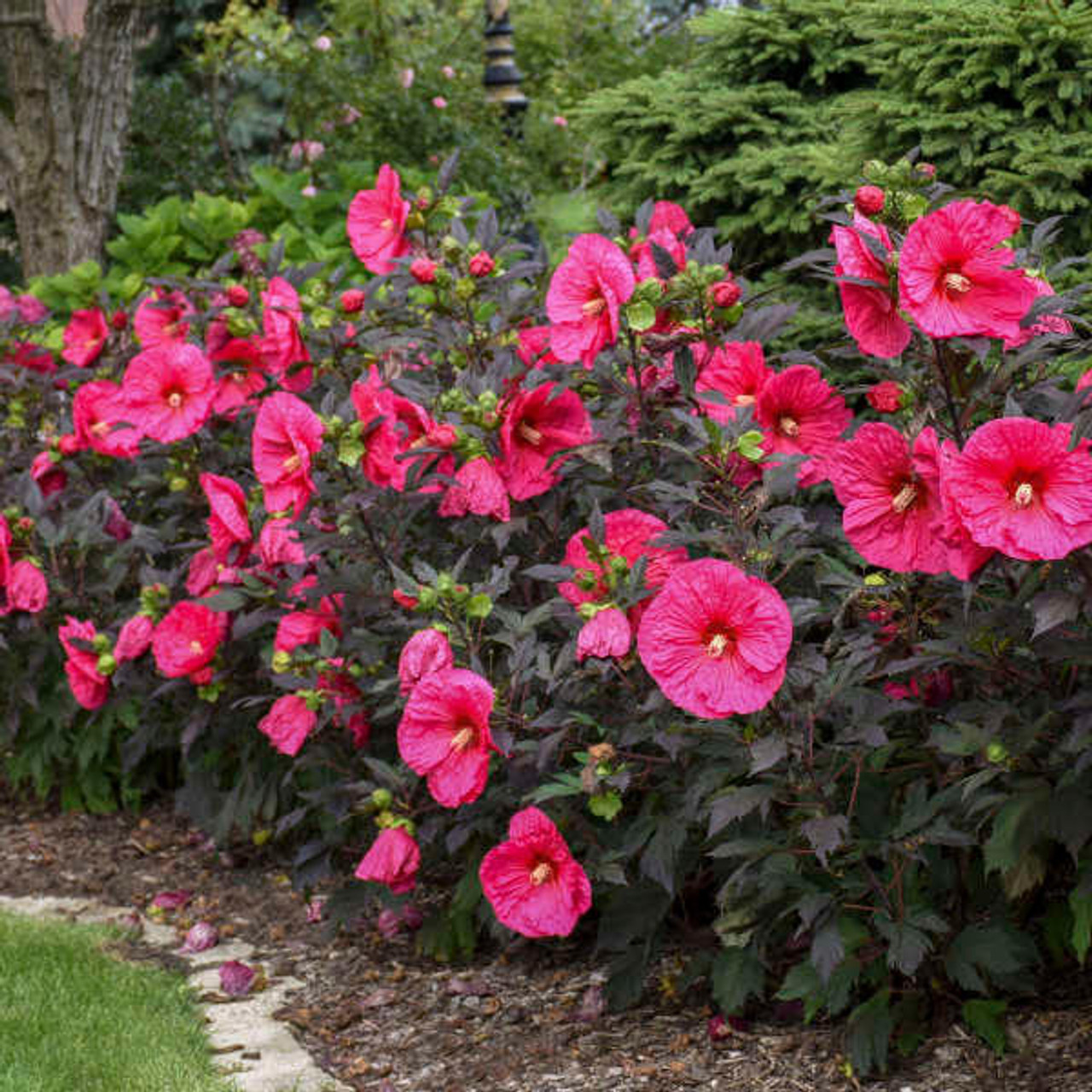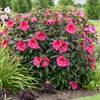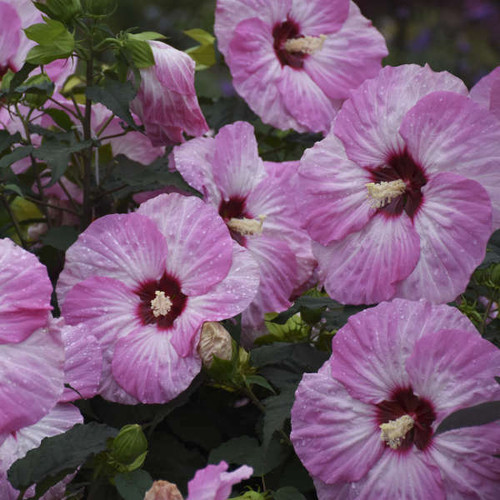Product Description
Hibiscus 'Evening Rose' PP33366 CPBRAF (25) Bare Root Plants
SUMMERIFIC® Collection
Common Name: Rose Mallow
Walters Gardens hybridizing has made a name for itself in hardy Hibiscus. There have been many different colors, and we are proud to introduce 'Evening Rose' as an excellent combination of hot pink flowers and near black foliage. 8" puckered flowers cover the round, dense habit top to bottom. Compared to 'Berry Awesome', the foliage is much darker and the flower color is more magenta than lavender. A must have statement piece for your garden!
Hibiscus love the sun and need moist, well-drained soil. Keeping these plants watered will result in larger flowers and lush foliage. Deadheading will improve the appearance of the plant. It is best to plant Hibiscus in the garden before the heat of the summer arrives and should be heavily mulched the first winter. In spring, cut back any remaining stems before new growth appears. A strong pair of loppers or a saw will be necessary to cut this plant back. Be advised that Hibiscus is always one of the last perennials to emerge in spring. Its vigorous growth rate more than makes up for this late start, however. Japanese beetles find these plants especially delicious.
Mississippi State University Ornamental Trial Top Performer -- 2019
Mississippi State University Ornamental Trial Top Performer -- 2021
Penn State Trials Top Performer -- 2020
University of Guelph Consumer Top 10 Perennial -- 2020
Height: 4.0 Feet
Spread: 4.5-5.0 Feet
Hardiness Zones: 4,5,6,7,8
Flower Color: Pink shades
Foliage Color: Near-black shades
Full Sun (> 6 hrs. Direct Sun) to Part Shade (4-6 hrs. Direct Sun)
Average to Consistent Water Needs
Poor to Fertile Soil Quality
Bloomtime: Midsummer - Late Summer
Attracts Butterflies
Bee Friendly
Deer Resistant
Growth Rate: Rapid
Bog Plant, Border Plant, Specimen, Focal Point
Hibiscus 'Evening Rose', also known as rose mallow, is a stunning hybrid variety of hardy hibiscus that is sure to be a showstopper in any garden. This herbaceous perennial boasts large, vibrant hot pink flowers that bloom from mid to late summer, creating a dramatic display against its near-black foliage. With its compact, well-branched habit and long blooming period, Hibiscus 'Evening Rose' is an excellent choice for adding a touch of the tropics to gardens in USDA Hardiness Zones 4 to 9.
Characteristics Hibiscus 'Evening Rose' has several notable characteristics that make it a standout plant:
- Flowers: The most striking feature of this hibiscus is its enormous, hot pink flowers. These blooms can reach up to 8 inches in diameter and have slightly ruffled petals that add to their visual appeal. The flowers emerge from numerous buds, ensuring a continuous display of color throughout the blooming season. Each flower lasts about a day, but new blooms continuously replace them, providing a long-lasting spectacle of color.
- Foliage: The dark, near-black foliage of Hibiscus 'Evening Rose' provides a dramatic contrast to the vibrant pink flowers. The oval-shaped leaves are slightly glossy, adding depth and texture to the plant. This rich foliage remains attractive throughout the growing season, enhancing the overall visual impact of the plant.
- Growth Habit: This hibiscus has an upright, bushy growth habit, reaching a height of 4 feet and a spread of 4-5 feet at maturity. It is well-branched and fills out quickly during the growing season, making it an excellent choice for adding structure to garden beds and borders.
- Hardiness: Hibiscus 'Evening Rose' is hardy in USDA Hardiness Zones 4 to 9, making it a versatile choice for a wide range of climates.
- Other Notable Features:
- Deer resistant
- Attracts bees and butterflies
- Fast-growing
- Low maintenance
Care Requirements Hibiscus 'Evening Rose' is a relatively low-maintenance plant, but providing the right growing conditions will ensure optimal health and flowering:
- Light: While it can tolerate some shade, Hibiscus 'Evening Rose' thrives in full sun, requiring at least 6 hours of direct sunlight daily for optimal blooming.
- Soil: This hibiscus prefers well-drained soil that is slightly acidic to neutral (pH 6.0-7.0). Enriching the soil with compost before planting will help provide the necessary nutrients.
- Water: Hibiscus 'Evening Rose' requires regular watering, especially during dry periods. Keep the soil consistently moist but not waterlogged.
- Fertilizer: Apply a balanced, slow-release fertilizer in early spring and again in mid-summer to promote vigorous growth.
- Pruning: Deadheading spent flowers will improve the plant's appearance and encourage further blooming. Prune in late winter or early spring before new growth appears to remove dead stems and encourage bushier growth.
- Mulching: Apply a 2-3 inch layer of mulch around the base of the plant to retain moisture, control weeds, and protect roots in winter.
- Pests and Diseases: While generally pest and disease resistant, Hibiscus 'Evening Rose' can be susceptible to aphids, Japanese beetles, caterpillars, and fungal diseases. Monitor the plant regularly and take appropriate action if necessary.
- Late Emergence: It is important to note that Hibiscus 'Evening Rose' is one of the last perennials to emerge in spring. Do not be alarmed if it seems slow to start; its vigorous growth rate will quickly make up for this late start.
Uses Hibiscus 'Evening Rose' is a versatile plant with various uses in the landscape:
- Garden Beds and Borders: Its upright habit and vibrant flowers make it an excellent choice for adding structure and color to garden beds and borders.
- Containers: This hibiscus can also be grown in large containers, making it suitable for patios, decks, and other outdoor spaces.
- Specimen Plant: Its striking appearance makes it an ideal specimen plant, drawing attention and adding a focal point to the garden.
- Bog Gardens and Water Features: Hibiscus 'Evening Rose' can tolerate wet soil, making it a suitable choice for bog gardens and areas near ponds and streams.
- Rain Gardens: It is also a good choice for rain gardens and other areas with poor drainage.
- Pollinator Gardens: The large, colorful flowers attract bees and butterflies, making it a valuable addition to pollinator gardens.
- Floating Eco-Islands: This hibiscus can be incorporated into floating eco-islands, adding a vibrant touch to water features.
Companion Plants To create a stunning and cohesive garden design, consider pairing Hibiscus 'Evening Rose' with these companion plants:
- Ornamental Grasses: The contrasting textures and forms of ornamental grasses complement the bold flowers and foliage of Hibiscus 'Evening Rose'.
- Asters: The late-season blooms of asters provide a beautiful color echo to the pink flowers of the hibiscus.
- Ironweed: The tall, purple flowers of ironweed create a striking vertical accent alongside the hibiscus.
- Rudbeckia: The golden yellow flowers of rudbeckia offer a warm contrast to the cool pink tones of Hibiscus 'Evening Rose'.
Hibiscus 'Evening Rose' is a captivating plant that offers both beauty and potential health benefits. Its stunning flowers, dark foliage, and low-maintenance nature make it a desirable addition to any garden. Whether used as a focal point, a border plant, or a container specimen, this hibiscus is sure to impress with its vibrant display and tropical charm. This hardy hibiscus thrives in a variety of climates and is relatively easy to care for, making it an excellent choice for both novice and experienced gardeners. Remember to provide it with ample moisture and sunlight for optimal growth and flowering. Consider adding Hibiscus 'Evening Rose' to your garden and enjoy its spectacular beauty and potential health benefits.
Other Details
The most important part of the plant is its root system. Healthy roots are the foundation of a healthy, vibrant plant. The type of plug container used is based on the specific needs of the plants. Perennials offered as bare root traditionally perform better when planted as bare root.Planted in a specialized mix, potted plants have well established root systems. Top growth stage will vary depending on the current life cycle and time of year when shipped. In Winter and early Spring dormant plants may be shipped. Dormant plants may be planted right away, even before the last frost date.
Most bare root varieties are field grown for at least one season, though Hemerocallis and Hosta are grown for two seasons. The bulk of the soil is removed during the harvesting process and the tops of most varieties are trimmed back to the crown. They are graded, packed in shredded aspen or sphagnum moss and stored in freezers until ready to be shipped.
See our Container Sizes and Bare Root Perennials pages for more information.
Plant information and care is provided in the Overview section, Plant Genus Page and general information is provided in the Planting Care & Guides. Additional questions can be asked on each Plant page.
Plant Spacing: Using the maximum mature spread or width of a plant to guide spacing, ensures space to grow to full size. To fill an area sooner, plant them closer together. Just remember, future thinning or transplanting may be needed.
Water: Keep a close eye on newly planted perennials, especially throughout the first growing year. Most early plant loss is due to too much or too little water!

















